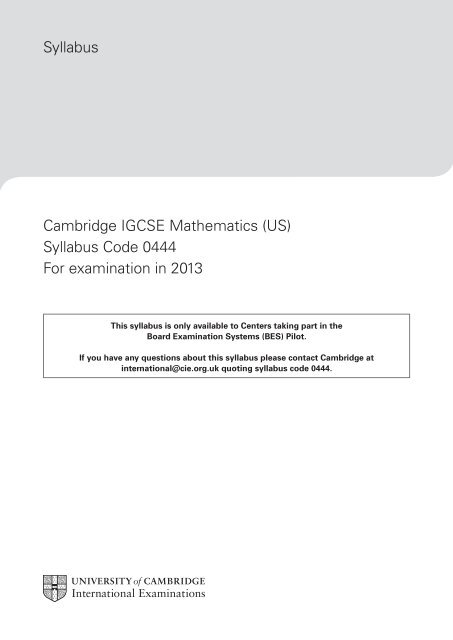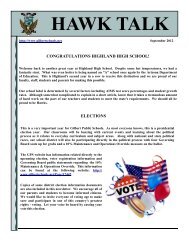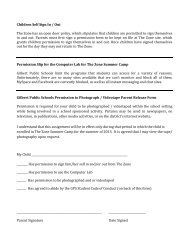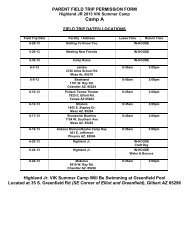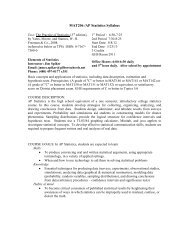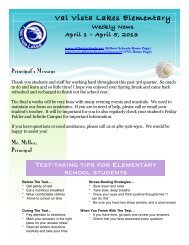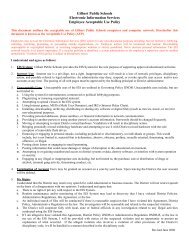Syllabus Cambridge IGCSE Mathematics (US) Syllabus Code 0444 ...
Syllabus Cambridge IGCSE Mathematics (US) Syllabus Code 0444 ...
Syllabus Cambridge IGCSE Mathematics (US) Syllabus Code 0444 ...
- No tags were found...
You also want an ePaper? Increase the reach of your titles
YUMPU automatically turns print PDFs into web optimized ePapers that Google loves.
<strong>Syllabus</strong><strong>Cambridge</strong> <strong>IGCSE</strong> <strong>Mathematics</strong> (<strong>US</strong>)<strong>Syllabus</strong> <strong>Code</strong> <strong>0444</strong>For examination in 2013This syllabus is only available to Centers taking part in theBoard Examination Systems (BES) Pilot.If you have any questions about this syllabus please contact <strong>Cambridge</strong> atinternational@cie.org.uk quoting syllabus code <strong>0444</strong>.
NoteAdministration materials appear in UK English and are standard for all our internationalcustomers. Please read the <strong>Cambridge</strong> Glossary alongside this syllabus. This is available fromour website.Summary of changes for examination in 2013The following content has been added for clarification:1.7 Explain the definition of radical exponents as an extension to integral components and explainthe rules for exponents (Core and Extended)1.9 Use units to understand problems and guide the solution to multi-step problems (Core andExtended)2.5 Manipulate algebraic expressions to prove identities (Extended only)2.9 Use equivalent forms of an expression or function to reveal and explain properties of thequantities or function represented (Extended only)4.8 Recognise that two shapes are congruent and use this to solve problems (Extended only)The following content is new:2.13 Be able to derive the formula for the sum of a finite geometric series and use the formula tosolve problems (Extended only)6.7 Identify the shapes of two-dimensional cross sections of three-dimensional objects and identifythree-dimensional objects generated by rotations of two-dimensional objects (Extended only)6.8 Apply concepts of density on area and volume modelling situations (Extended only)6.9 Apply geometric methods to solve design problems (Extended only)
Contents<strong>Cambridge</strong> <strong>IGCSE</strong> <strong>Mathematics</strong> (<strong>US</strong>)<strong>Syllabus</strong> <strong>Code</strong> <strong>0444</strong>1. Introduction ..................................................................................... 21.1 Why Choose <strong>Cambridge</strong>?1.2 Why Choose <strong>Cambridge</strong> <strong>IGCSE</strong> <strong>Mathematics</strong> (<strong>US</strong>)?1.3 <strong>Cambridge</strong> International Certificate of Education (ICE)1.4 How Can I Find Out More?2. Assessment at a Glance .................................................................. 43. <strong>Syllabus</strong> Goals and Objectives ......................................................... 63.1 Goals3.2 Assessment Objectives4. Curriculum Content ......................................................................... 85. Additional Information ................................................................... 365.1 Guided Learning Hours5.2 Recommended Prerequisites5.3 Progression5.4 Component <strong>Code</strong>s5.5 Grading and Reporting5.6 Resources6. Appendix ....................................................................................... 386.1 Mathematical Formulae for Core Components (1 and 3)6.2 Mathematical Formulae for Extended Components (2 and 4)Alterations in the syllabus are indicated by black vertical lines on either side of the text.<strong>Cambridge</strong> <strong>IGCSE</strong> <strong>Mathematics</strong> (<strong>US</strong>) <strong>0444</strong>. For examination in 2013.© University of <strong>Cambridge</strong> International Examinations 2011
1. Introduction1.1 Why Choose <strong>Cambridge</strong>?University of <strong>Cambridge</strong> International Examinations (CIE) is the world’s largest provider of internationalqualifications. Around 1.5 million candidates from 150 countries enter <strong>Cambridge</strong> examinations every year.What makes educators around the world choose <strong>Cambridge</strong>?Recognition<strong>Cambridge</strong> International General Certificate of Secondary Education (<strong>IGCSE</strong>) is internationally recognizedby schools, universities, and employers as equivalent to UK GCSE. <strong>Cambridge</strong> <strong>IGCSE</strong> is excellentpreparation for GCE A and AS Levels, the Advanced International Certificate of Education (AICE), the<strong>US</strong> Advanced Placement Program, and the International Baccalaureate (IB) Diploma. Learn more atwww.cie.org.uk/recognition.SupportCIE provides a world-class support service for teachers and exams officers. We offer a wide range ofteacher materials to Centers, plus teacher training (online and face-to-face) and candidate support materials.Exams officers can trust in reliable, efficient administration of exams entry and excellent, personal supportfrom CIE Customer Services. Learn more at www.cie.org.uk/teachers.Excellence in Education<strong>Cambridge</strong> qualifications develop successful candidates. They build not only understanding and knowledgerequired for progression to college, work, or further examinations but also learning and thinking skills thathelp candidates become independent learners and equip them for life.Nonprofit, Part of the University of <strong>Cambridge</strong>CIE is part of <strong>Cambridge</strong> Assessment, a nonprofit organization, and part of the University of <strong>Cambridge</strong>.The needs of teachers and learners are at the core of what we do. CIE invests constantly in improving itsqualifications and services. We draw upon education research in developing our qualifications.<strong>Cambridge</strong> <strong>IGCSE</strong> <strong>Mathematics</strong> (<strong>US</strong>) <strong>0444</strong>. For examination in 2013.2
1. Introduction1.2 Why Choose <strong>Cambridge</strong> <strong>IGCSE</strong> <strong>Mathematics</strong> (<strong>US</strong>)?<strong>Cambridge</strong> <strong>IGCSE</strong> <strong>Mathematics</strong> is accepted by universities and employers as proof of mathematicalknowledge and understanding. Successful <strong>IGCSE</strong> <strong>Mathematics</strong> candidates gain lifelong skills, including:• the development of their mathematical knowledge;• confidence by developing a feel for numbers, patterns, and relationships;• an ability to consider and solve problems and present and interpret results;• communication and reason using mathematical concepts;• a solid foundation for further study.1.3 <strong>Cambridge</strong> International Certificate of Education (ICE)<strong>Cambridge</strong> ICE is the group award of the <strong>IGCSE</strong>. It requires the study of subjects drawn from the fivedifferent <strong>IGCSE</strong> subject groups. It gives Centers the opportunity to benefit from offering a broad andbalanced curriculum by recognizing the achievements of students who pass examinations in at least sevensubjects, including two languages, and one subject from each of the other subject groups.The <strong>Cambridge</strong> portfolio of <strong>IGCSE</strong> qualifications provides a solid foundation for higher-level courses suchas GCE A and AS Levels and the International Baccalaureate Diploma as well as excellent preparation foremployment.A wide range of <strong>IGCSE</strong> subjects is available and these are grouped into five curriculum areas. <strong>Mathematics</strong>(<strong>0444</strong>) falls in Group IV, <strong>Mathematics</strong>.Learn more about ICE at www.cie.org.uk/qualifications/academic/middlesec/ice.1.4 How Can I Find Out More?If You Are Already a <strong>Cambridge</strong> CenterYou can make entries for this qualification through your usual channels, e.g., CIE Direct. If you have anyqueries, please contact us at international@cie.org.uk.If You Are Not a <strong>Cambridge</strong> CenterYou can find out how your organization can become a <strong>Cambridge</strong> Center. Email us atinternational@cie.org.uk. Learn more about the benefits of becoming a <strong>Cambridge</strong> Center atwww.cie.org.uk.3<strong>Cambridge</strong> <strong>IGCSE</strong> <strong>Mathematics</strong> (<strong>US</strong>) <strong>0444</strong>. For examination in 2013.
2. Assessment at a Glance<strong>Cambridge</strong> <strong>IGCSE</strong> <strong>Mathematics</strong> (<strong>US</strong>)<strong>Syllabus</strong> <strong>Code</strong> <strong>0444</strong>This qualification is assessed via two components.Candidates who have followed the Core curriculum take components 1 and 3.Candidates who have followed the Extended curriculum take components 2 and 4.Component Weighting RawmarkNature ofassessment1 Written paper 1 hourShort-answer questions based on the Corecurriculum.Calculators are not permitted.Grades available: C–G2 Written paper 1 hour, 30 minutesShort-answer questions based on the Extendedcurriculum.Calculators are not permitted.Grades available: A*–E3 Written paper 2 hoursStructured questions based on the Corecurriculum.Electronic calculators are required. †Grades available: C–G4 Written paper 2 hours, 30 minutesStructured questions based on the Extendedcurriculum.Electronic calculators are required. †Grades available: A*–E35% 56 External35% 70 External65% 104 External65% 130 External† Algebraic or graphic calculators are not permitted.The mathematical formulae provided in the written papers is given in the appendix.<strong>Cambridge</strong> <strong>IGCSE</strong> <strong>Mathematics</strong> (<strong>US</strong>) <strong>0444</strong>. For examination in 2013.4
2. Assessment at a GlanceAvailabilityThis syllabus is examined in the May/June examination session and the October/November examinationsession.Combining This with Other SyllabiCandidates can combine this syllabus in an examination session with any other CIE syllabus, except:• syllabi with the same title (or the title <strong>Mathematics</strong>) at the same levelCandidates who follow the Extended Curriculum of the <strong>Cambridge</strong> <strong>IGCSE</strong> <strong>Mathematics</strong> (<strong>US</strong>) (<strong>0444</strong>) and the<strong>Cambridge</strong> <strong>IGCSE</strong> Additional <strong>Mathematics</strong> (<strong>US</strong>) (0459) syllabus content will cover the Common Core StateStandards for <strong>Mathematics</strong> (CCSSM) for Grades 9–12.5<strong>Cambridge</strong> <strong>IGCSE</strong> <strong>Mathematics</strong> (<strong>US</strong>) <strong>0444</strong>. For examination in 2013.
3. <strong>Syllabus</strong> Goals and Objectives3.1 Goals<strong>Cambridge</strong> <strong>IGCSE</strong> <strong>Mathematics</strong> syllabus is designed as a two-year course for examination at age 16-plus.The goals of this syllabus should enable students to:1. develop their mathematical knowledge and oral, written, and practical skills in a way that encouragesconfidence and provides satisfaction and enjoyment;2. read mathematics, and write and talk about the subject in a variety of ways;3. develop a feel for numbers, carry out calculations, and understand the significance of the resultsobtained;4. apply mathematics in everyday situations and develop an understanding of the part that mathematicsplays in the world around them;5. solve problems, present the solutions clearly, check and interpret the results;6. develop an understanding of mathematical principles;7. recognize when and how a situation may be represented mathematically, identify and interpret relevantfactors, and, where necessary, select an appropriate mathematical method to solve the problem;8. use mathematics as a means of communication with emphasis on the use of clear expression;9. develop an ability to apply mathematics in other subjects, particularly science and technology;10. develop the abilities to reason logically, to classify, to generalize, and to prove;11. appreciate patterns and relationships in mathematics;12. produce and appreciate imaginative and creative work arising from mathematical ideas;13. develop their mathematical abilities by considering problems and conducting individual and cooperativeenquiry and experiment, including extended pieces of work of a practical and investigative kind;14. appreciate the interdependence of different branches of mathematics;15. acquire a foundation appropriate to their further study of mathematics and of other disciplines.<strong>Cambridge</strong> <strong>IGCSE</strong> <strong>Mathematics</strong> (<strong>US</strong>) <strong>0444</strong>. For examination in 2013.6
3. <strong>Syllabus</strong> Goals and Objectives3.2 Assessment ObjectivesThe examination will test the ability of candidates to:1. organize, interpret, and present information accurately in written, tabular, graphical, and diagrammaticforms;2. perform calculations by suitable methods;3. use an electronic calculator and also perform some straightforward calculations without a calculator;4. understand systems of measurement in everyday use and make use of them in the solution ofproblems;5. estimate, approximate, and work to degrees of accuracy appropriate to the context and convert betweenequivalent numerical forms;6. use mathematical and other instruments to measure and to draw to an acceptable degree of accuracy;7. interpret, transform, and make appropriate use of mathematical statements expressed in words orsymbols;8. recognize and use spatial relationships in two and three dimensions, particularly in solving problems;9. recall, apply, and interpret mathematical knowledge in the context of everyday situations.10. make logical deductions from given mathematical data;11. recognize patterns and structures in a variety of situations, and form generalizations;12. respond to a problem relating to a relatively unstructured situation by translating it into an appropriatelystructured form;13. analyze a problem, select a suitable strategy, and apply an appropriate technique to obtain its solution;14. apply combinations of mathematical skills and techniques in problem solving;15. set out mathematical work, including the solution of problems, in a logical and clear form usingappropriate symbols and terminology;16. present concise reasoned arguments to justify solutions or generalizations, using symbols diagrams orgraphs and related explanations.7<strong>Cambridge</strong> <strong>IGCSE</strong> <strong>Mathematics</strong> (<strong>US</strong>) <strong>0444</strong>. For examination in 2013.
4. Curriculum ContentCandidates may follow either the Core Curriculum or the Extended Curriculum. Candidates aiming forGrades A*–C should follow the Extended Curriculum.1. Number—Core curriculum Notes / Examples1.1 Knowledge of: natural numbers, integers(positive, negative, and zero), prime numbers,square numbers, rational and irrational numbers,real numbers.Use of symbols: =, ≠, Ğ, ğ, 1.2 Use of the four operations and parentheses. Applies to integers, fractions, and decimals.Choose mental or written methodsappropriate to the number or context.1.3 Multiples and factors, including greatest commonfactor, least common multiple.1.4 Ratio and proportion.1.5 Language and notation of fractions, decimals, andpercentages; recognize equivalences betweendecimals, fractions, ratios, and percentages andconvert between them.GCF and LCM will be used and knowledgeof prime factors is assumed.Order quantities given in different forms bymagnitude, by first converting into same form.1.6 Percentages, including applications such as interestand profit.Excludes reverse percentages.Includes both simple and compoundinterest.<strong>Cambridge</strong> <strong>IGCSE</strong> <strong>Mathematics</strong> (<strong>US</strong>) <strong>0444</strong>. For examination in 2013.8
4. Curriculum Content1. Number—Extended curriculum Notes / Examples1.1 Knowledge of: natural numbers, integers(positive, negative, and zero), prime numbers,square numbers, rational and irrational numbers,real numbers.Use of symbols: =, ≠, Ğ, ğ, Understand that the sum or product oftwo rational numbers is rational; that thesum of a rational number and an irrationalnumber is irrational; and that the product ofa non-zero rational number and an irrationalnumber is irrational.1.2 Use of the four operations and parentheses. Applies to integers, fractions, and decimals.Choose mental or written methodsappropriate to the number or context.1.3 Multiples and factors, including greatest commonfactor, least common multiple.1.4 Ratio and proportion.1.5 Understand and use the language and notation offractions, decimals, and percentages; recognizeequivalences between decimals, fractions, ratios,and percentages and convert between them.Order quantities given in different forms bymagnitude, by first converting into same form.GCF and LCM will be used and knowledgeof prime factors is assumed.1.6 Percentages, including applications such as interestand profit.Includes reverse percentages.Includes both simple and compoundinterest.Includes percentiles.9<strong>Cambridge</strong> <strong>IGCSE</strong> <strong>Mathematics</strong> (<strong>US</strong>) <strong>0444</strong>. For examination in 2013.
4. Curriculum Content1. Number—Core curriculum Notes / Examples1.7 Meaning and calculation of exponents (powers,indices) including positive, negative, and zeroexponents.e.g., work out 4 –3 as a fraction.Explain the definition of radical exponents as anextension to integral exponents.Explain the rules for exponents.Scientific notation (Standard Form) a × 10 n where1 Ğ a < 10 and n is an integer.1.8 Radicals, calculation of square root and cube rootexpressions.e.g., work out 2 4 × 2 –3Convert numbers in and out of scientificnotation.Calculate with values in scientific notation.e.g., the area of a square is 54.76 cm 2 .Work out the length of one side of thesquare.Find the value of the cube root of 64.1.9 Use units to understand problems and guide thesolution to multi-step problems.Quantities—choose and interpret units and scales,define appropriate quantities (including money).Estimating, rounding, decimal places, and significantfigures—choose a level of accuracy appropriate for aproblem.1.10 Calculations involving time: seconds (s), minutes(min), hours (h), days, months, years including therelation between consecutive units.1.11 Speed, distance, time problems.Also relates to graphs and geometricalmeasurement topics.Includes converting between units,e.g., different currencies.Use estimation to check answers andconsider whether the answer is reasonablein the context of the problem.1 year = 365 days.Includes familiarity with both 24-hour and12-hour clocks and extraction of data fromdials and schedules.<strong>Cambridge</strong> <strong>IGCSE</strong> <strong>Mathematics</strong> (<strong>US</strong>) <strong>0444</strong>. For examination in 2013.10
4. Curriculum Content1. Number—Extended curriculum Notes / Examples1.7 Meaning and calculation of exponents (powers,indices) including positive, negative, zero andfractional exponents.1e.g., 52= 5Evaluate 5 –2 1, 100 2 -2, 8 3Explain the definition of radical exponents as anextension to integral exponents.Explain the rules for exponents.Scientific notation (Standard Form) a × 10 n where1 Ğ a < 10 and n is an integer.1.8 Radicals, calculation and simplification of squareroot and cube root expressions.Work out 2 4 × 2 –3Convert numbers in and out of scientificnotation.Calculate with values in scientific notation.e.g., simplify 200 + 18Write (2 + 3 ) 2in the form a + b 31.9 Use units to understand problems and guide thesolution to multi-step problems.Quantities—choose and interpret units and scales,define appropriate quantities (including money).Estimating, rounding, decimal places, and significantfigures—choose a level of accuracy appropriate for aproblem.1.10 Calculations involving time: seconds (s), minutes(min), hours (h), days, months, years including therelation between consecutive units.1.11 Speed, distance, time problems.Also relates to graphs and geometricalmeasurement topics.Includes converting between units,e.g., different currencies.Use estimation to check answers andconsider whether the answer is reasonablein the context of the problem.1 year = 365 days.Includes familiarity with both 24-hour and12-hour clocks and extraction of data fromdials and schedules.11<strong>Cambridge</strong> <strong>IGCSE</strong> <strong>Mathematics</strong> (<strong>US</strong>) <strong>0444</strong>. For examination in 2013.
4. Curriculum Content2. Algebra—Core curriculum Notes / Examples2.1 Extended Curriculum only.2.2 Extended Curriculum only.2.3 Create expressions and create and solve linearequations, including those with fractionalexpressions.Explain each algebraic step of the solution.May be asked to interpret solutions to aproblem given in context.Construct a viable argument to justify asolution method.2.4 Exponents (indices). Includes rules of indices with negativeindices.Simple examples only,e.g., q 3 × q –4 , 8x 5 ÷ 2x 22.5 Rearrangement and evaluation of simple formulae. e.g., make r the subject of:• p = rt – q• w =r-tye.g., when x = –3 and y = 4, find the valueof xy 2 .2.6 Create and solve simultaneous linear equations intwo variables algebraically.2.7 Identify terms, factors, and coefficients.2.8 Expansion of parentheses (simple examples only).Simplify expressions.e.g., expand and simplify 4(5c – 3d ) – 7c<strong>Cambridge</strong> <strong>IGCSE</strong> <strong>Mathematics</strong> (<strong>US</strong>) <strong>0444</strong>. For examination in 2013.12
4. Curriculum Content2. Algebra—Extended curriculum Notes / Examples2.1 Writing, showing, and interpretation of inequalitieson the real number line.2.2 Create and solve linear inequalities. e.g., Solve 3x + 5 < 7Solve –7 Ğ 3n – 1 < 52.3 Create expressions and create and solve linearequations, including those with fractionalexpressions.Explain each algebraic step of the solution.May be asked to interpret solutions to aproblem given in context.Construct a viable argument to justify asolution method.2.4 Exponents (indices). Includes rules of indices with negative andfractional indices.32e.g., simplify 2x# 5x2.5 Rearrangement and evaluation of formulae. Includes manipulation of algebraicexpressions to prove identities.Formulae may include indices or caseswhere the subject appears twice.e.g., make r the subject of• V = rr• p =4 332r- 3r+se.g., y = m 2 – 4n 2-4Find the value of y when m = 4.4 andn = 2.82.6 Create and solve simultaneous linear equations intwo variables algebraically and graphically.2.7 Identify terms, factors, and coefficients.Interpret algebraic expressions in terms of acontext.2.8 Expansion of parentheses, including the square of abinomial. Simplify expressions.See functions 3.2e.g., interpret P (1 + r ) n as the product of Pand a factor not depending on P.e.g., expand (2x – 5) 2 = 4x 2 – 20x + 2513<strong>Cambridge</strong> <strong>IGCSE</strong> <strong>Mathematics</strong> (<strong>US</strong>) <strong>0444</strong>. For examination in 2013.
4. Curriculum Content2. Algebra—Core curriculum Notes / Examples2.9 Factorization: common factor only. e.g., 6x 2 + 9x = 3x(2x + 3)2.10 Extended Curriculum only.2.11 Extended Curriculum only.2.12 Extended Curriculum only.2.13 Continuation of a sequence of numbers orpatterns; recognize patterns in sequences;generalize to simple algebraic statements, includingdetermination of the n th term.e.g., find the n th term of:• 5 9 13 17 21• 2 4 8 16 322.14 Extended Curriculum only.<strong>Cambridge</strong> <strong>IGCSE</strong> <strong>Mathematics</strong> (<strong>US</strong>) <strong>0444</strong>. For examination in 2013.14
4. Curriculum Content2. Algebra—Extended curriculum Notes / Examples2.9 Use equivalent forms of an expression or functionto reveal and explain properties of the quantities orfunction represented.Factorization:common factordifference of squarestrinomialfour term.2.10 Algebraic fractions:simplification, including use of factorizationaddition or subtraction of fractions with lineardenominatorsmultiplication or division and simplification of twofractions.2.11 Create and solve quadratic equations by:inspectionfactorizationusing the quadratic formulacompleting the square.2.12 Solve simple rational and radical equations in onevariable and discount any extraneous solutions.2.13 Continuation of a sequence of numbers orpatterns; recognize patterns in sequences;generalize to simple algebraic statements, includingdetermination of the n th term.Derive the formula for the sum of a finite geometricseries, and use the formula to solve problems.2.14 Express direct and inverse variation in algebraicterms and use this form of expression to findunknown quantities.6x 2 + 9x = 3x(2x + 3)9x 2 – 16y 2 = (3x – 4y )(3x + 4y )6x 2 + 11x – 10 = (3x – 2)(2x + 5)xy – 3x + 2y – 6 = (x + 2)(y – 3)Use the structure of an expression toidentify ways to rewrite it, for example, seex 4 – y 4 as (x 2 ) 2 – (y 2 ) 2 , thus recognizing it asa difference of squares that can be factoredas (x 2 – y 2 )(x 2 + y 2 ).e.g., simplify7x4y2 '21x824x- 92,8x- 10x-33-4,2x+ 1 xe.g., x ² = 492x ² + 5x – 3 = 03x ² – 2x – 7 = 0Write x ² – 6x + 9 in the form (x – a) 2 + b andstate the minimum value of the function.Quadratic formula will be given.e.g., solve x + 2 = 6, x –3 = 27, 2y 4 = 32e.g., find the n th term of:• 5 9 13 17 21• 2 4 8 16 32• 2 5 10 17 26• 3 6 12 24 48For a common ratio that is not 1.e.g., calculate mortgage payments.e.g., y ú x, y úy ú x1 , y ú x12x15<strong>Cambridge</strong> <strong>IGCSE</strong> <strong>Mathematics</strong> (<strong>US</strong>) <strong>0444</strong>. For examination in 2013.
4. Curriculum Content3. Functions—Core curriculum Notes / Examples3.1 Use function notation.Knowledge of domain and range.Mapping diagrams.3.2 Understand and explain that the graph of anequation in two variables is the set of all itssolutions plotted in the co-ordinate plane.Understand that a function assigns to eachelement of the domain exactly one elementof the range. If f is a function and x is anelement of its domain then f(x) denotes theoutput of f corresponding to the input of x.Construct tables of values for functions of the formax + b, ± x 2 + ax + b, xa (x ¸ 0) where a and b areintegral constants; draw and interpret such graphs.Solve associated equations approximately bygraphical methods.3.3 Write a function that describes a relationshipbetween two quantities.e.g., C(x) = 50,000 + 400x models thecost of producing x wheelchairs. Write afunction that represents the cost of onewheelchair.3.4 Extended Curriculum only.<strong>Cambridge</strong> <strong>IGCSE</strong> <strong>Mathematics</strong> (<strong>US</strong>) <strong>0444</strong>. For examination in 2013.16
4. Curriculum Content3. Functions—Extended curriculum Notes / Examples3.1 Use function notation.Knowledge of domain and range.Mapping diagrams.3.2 Understand and explain that the graph of anequation in two variables is the set of all itssolutions plotted in the co-ordinate plane.e.g., f(x); f:xUnderstand that a function assigns to eachelement of the domain exactly one elementof the range. If f is a function and x is anelement of its domain then f(x) denotes theoutput of f corresponding to the input of x.Construct tables of values and construct graphsof functions of the form ax n where a is a rationalconstant and n = –2, –1, 0, 1, 2, 3 and simple sumsof not more than three of these and for functions ofthe type a x where a is a positive integer.Solve associated equations approximately bygraphical methods.3.3 Write a function that describes a relationshipbetween two quantities.3.4 Compare properties of two functions eachrepresented in a different way (algebraically,graphically, numerically in tables, or by verbaldescriptions).e.g., C(x) = 50,000 + 400x models thecost of producing x wheelchairs. Write afunction that represents the cost of onewheelchair.e.g., given a graph of one quadratic functionand an algebraic expression for another, saywhich has the larger maximum.17<strong>Cambridge</strong> <strong>IGCSE</strong> <strong>Mathematics</strong> (<strong>US</strong>) <strong>0444</strong>. For examination in 2013.
4. Curriculum Content3. Functions—Core curriculum Notes / Examples3.5 Recognition of the following function types from theshape of their graphs:linear f(x) = ax + bquadratic f(x) = ax 2 + bx + creciprocal f(x) = xaSome of a, b, c may be 0Interpret the key features of the graphs—toinclude intercepts; intervals where the function isincreasing, decreasing, positive, negative; relativemaxima and minima; symmetries; end behavior.3.6 Relate the domain of a function to its graph and,where applicable, to the quantitative relationship itdescribes.e.g., if the function h(n) gives the numberof person-hours it takes to assemblen engines in a factory, then the positiveintegers would be an appropriate domainfor the function.3.7 Extended Curriculum only.3.8 Extended Curriculum only.<strong>Cambridge</strong> <strong>IGCSE</strong> <strong>Mathematics</strong> (<strong>US</strong>) <strong>0444</strong>. For examination in 2013.18
4. Curriculum Content3. Functions—Extended curriculum Notes / Examples3.5 Recognition of the following function types from theshape of their graphs:linear f(x) = ax + bquadratic f(x) = ax 2 + bx + ccubic f(x) = ax 3 + bx 2 + cx + dareciprocal f(x)= xexponential f(x) = a x with 0 < a < 1 or a > 1trigonometric f(x) = asin(bx); acos(bx); tanxInterpret the key features of the graphs—toinclude intercepts; intervals where the function isincreasing, decreasing, positive, negative; relativemaxima and minima; symmetries; end behavior andperiodicity.3.6 Relate the domain of a function to its graph and,where applicable, to the quantitative relationship itdescribes.3.7 Calculate and interpret the average rate of changeof a function (presented symbolically or as a table)over a specified interval.Estimate the rate of change from a graph.3.8 Behavior of linear, quadratic, and exponentialfunctions:linear f(x) = ax + bquadratic f(x) = ax 2 + bx + cexponential f(x) = a x with 0 < a < 1 or a > 1Some of a, b, c, and d may be 0Including period and amplitude.e.g., if the function h(n) gives the numberof person-hours it takes to assemble nengines in a factory, then the positiveintegers would be an appropriate domainfor the function.e.g., average speed between 2 pointse.g., use a tangent to the curve to find theslopeObserve, using graphs and tables, that aquantity increasing exponentially eventuallyexceeds a quantity increasing linearly,quadratically, or (more generally) as apolynomial function.Use the properties of exponents to interpretexpressions for exponential functions,e.g., identify percent rate of change infunctions such as y = (1.02) t , y = (0.97) t ,y = (1.01) 12t , y = (1.2) t/10 , and classify them asrepresenting exponential growth or decay.19<strong>Cambridge</strong> <strong>IGCSE</strong> <strong>Mathematics</strong> (<strong>US</strong>) <strong>0444</strong>. For examination in 2013.
4. Curriculum Content3. Functions—Core curriculum Notes / Examples3.9 Extended Curriculum only.3.10 Extended Curriculum only.3.11 Extended Curriculum only.3.12 Description and identification, using the languageof transformations, of the changes to the graph ofy = f(x) when y = f(x) + k, y = k f(x), y = f(x + k)for f(x) given in section 3.5.Where k is an integer.3.13 Extended Curriculum only.4. Geometry—Core curriculum Notes / Examples4.1 Vocabulary:acute, obtuse, right angle, reflex, equilateral,isosceles, congruent, similar, regular, pentagon,hexagon, octagon, rectangle, square, kite, rhombus,parallelogram, trapezoid, and simple solid figures.4.2 Definitions:Know precise definitions of angle, circle,perpendicular line, parallel line, and line segment,based on the undefined notions of point, line,distance along a line, and distance around acircular arc.<strong>Cambridge</strong> <strong>IGCSE</strong> <strong>Mathematics</strong> (<strong>US</strong>) <strong>0444</strong>. For examination in 2013.20
4. Curriculum Content3. Functions—Extended curriculum Notes / Examples3.9 Construct linear and exponential functions, includingarithmetic and geometric sequences, given a graph,a description of a relationship, or two input-outputpairs (include reading these from a table).e.g., find the function or equation for therelationship between x and yx –2 0 2 4y 3 5 7 93.10 Simplification of formulae for composite functionssuch as f(g(x)) where g(x) is a linear expression.e.g., f(x) = 6 + 2x, g(x) = 7x,f(g(x)) = 6 + 2(7x) = 6 + 14x3.11 Inverse function f –1 . Find an inverse function.Solve equation of form f(x) = c for a simplefunction that has an inverse.Read values of an inverse function from agraph or a table, given that the function hasan inverse.3.12 Description and identification, using the languageof transformations, of the changes to the graph ofy = f(x) when y = f(x) + k, y = k f(x), y = f(x + k) forf(x) given in section 3.5.3.13 Graph the solutions to a linear inequality in twovariables as a half-plane (region), excluding theboundary in the case of a strict inequality. Graph thesolution set to a system of linear inequalities in twovariables as the intersection of the correspondinghalf-planes.Where k is an integer.e.g., identify the region bounded by theinequalitiesy > 3, 2x + y < 12, y Ğ x.4. Geometry—Extended curriculum Notes / Examples4.1 Vocabulary:Know precise definitions of acute, obtuse, rightangle, reflex, equilateral, isosceles, congruent,similar, regular, pentagon, hexagon, octagon,rectangle, square, kite, rhombus, parallelogram,trapezoid, and simple solid figures.4.2 Definitions:Know precise definitions of angle, circle,perpendicular line, parallel line, and line segment,based on the undefined notions of point, line,distance along a line, and distance around acircular arc.21<strong>Cambridge</strong> <strong>IGCSE</strong> <strong>Mathematics</strong> (<strong>US</strong>) <strong>0444</strong>. For examination in 2013.
4. Curriculum Content4. Geometry—Core curriculum Notes / Examples4.3 Line and rotational symmetry in 2D. e.g., know properties of triangles,quadrilaterals, and circles directly relatedto their symmetries.4.4 Angles around a point.Angles on a straight line and intersecting straightlines.Vertically opposite angles.Alternate and corresponding angles on parallel lines.Angle properties of triangles, quadrilaterals, andpolygons.Interior and exterior angles of a polygon.Formal proof is not required, butcandidates will be expected to usereasoned arguments, includingjustifications, to establish geometricresults from given information.4.5 Construction.Make formal geometric constructions with compassand straight edge only.Copy a segment; copy an angle; bisect a segment;bisect an angle; construct perpendicular lines,including the perpendicular bisector of a linesegment.Construct an equilateral triangle, a square, and aregular hexagon inscribed in a circle.Construct the inscribed and circumscribed circles ofa triangle.Construct a tangent line from a point outside a givencircle to the circle.Angle measurement in degrees.Read and make scale drawings.<strong>Cambridge</strong> <strong>IGCSE</strong> <strong>Mathematics</strong> (<strong>US</strong>) <strong>0444</strong>. For examination in 2013.22
4. Curriculum Content4. Geometry—Extended curriculum Notes / Examples4.3 Line and rotational symmetry in 2D and 3D. e.g., know properties of triangles,quadrilaterals, and circles directly relatedto their symmetries.For example, given a rectangle,parallelogram, trapezoid or regular polygon,describe the rotations and reflections thatcarry it onto itself.Recognize symmetry properties of theprism and the pyramid.4.4 Angles around a point.Angles on a straight line and intersecting straightlines.Vertically opposite angles.Alternate and corresponding angles on parallel lines.Angle properties of triangles, quadrilaterals, andpolygons.Interior and exterior angles of a polygon.Formal proof is not required, butcandidates will be expected to usereasoned arguments, includingjustifications, to establish geometricresults from given information.4.5 Construction.Make formal geometric constructions with compassand straight edge only.Copy a segment; copy an angle; bisect a segment;bisect an angle; construct perpendicular lines,including the perpendicular bisector of a linesegment.Construct an equilateral triangle, a square, and aregular hexagon inscribed in a circle.Construct the inscribed and circumscribed circles ofa triangle.Construct a tangent line from a point outside a givencircle to the circle.Angle measurement in degrees.Read and make scale drawings.23<strong>Cambridge</strong> <strong>IGCSE</strong> <strong>Mathematics</strong> (<strong>US</strong>) <strong>0444</strong>. For examination in 2013.
4. Curriculum Content4. Geometry—Core curriculum Notes / Examples4.6 Vocabulary of circles.Properties of circles:• tangent perpendicular to radius at the point ofcontact• angle in a semicircleFormal proof is not required butcandidates will be expected to usereasoned arguments, includingjustifications, to establish geometricresults from given information.4.7 Similarity.Calculation of lengths of similar figures.Use scale factors and/or angles to checkfor similarity.4.8 Extended Curriculum only.5. Transformations and vectors—Core curriculum Notes / Examples5.1 Vector notation:directed line segment AB ;⎛ x ⎞component form ⎜ ⎟⎝y⎠5.2 Extended Curriculum only.<strong>Cambridge</strong> <strong>IGCSE</strong> <strong>Mathematics</strong> (<strong>US</strong>) <strong>0444</strong>. For examination in 2013.24
4. Curriculum Content4. Geometry—Extended curriculum Notes / Examples4.6 Vocabulary of circles.Properties of circles:• tangent perpendicular to radius at the point ofcontact• tangents from a point• angle in a semicircle• angles at the center and at the circumference onthe same arc• cyclic quadrilateralFormal proof is not required but candidateswill be expected to use reasonedarguments, including justifications, toestablish geometric results from giveninformation.Use the following symmetry properties of a circle:• equal chords are equidistant from the center• the perpendicular bisector of a chord passesthrough the center• tangents from an external point are equal inlength4.7 Similarity.Calculation of lengths of similar figures.Area and volume scale factors.4.8 Congruence.Recognise that two shapes are congruent and usethis to solve problems.Use scale factors and/or angles to checkfor similarity.Use of the relationships between areas ofsimilar figures and extension to volumesand surface areas of similar solids.5. Transformations and vectors—Extended curriculum Notes / Examples5.1 Vector notation:a; directed line segment AB ;⎛ x ⎞component form ⎜ ⎟⎝y⎠use appropriate symbols for vectors and theirmagnitudes5.2 Find the components of a vector by subtracting theco-ordinates of an initial point from the co-ordinatesof a terminal point.Use position vectors.e.g., v, |v|See also section 5.6, translations usingcolumn vectors.25<strong>Cambridge</strong> <strong>IGCSE</strong> <strong>Mathematics</strong> (<strong>US</strong>) <strong>0444</strong>. For examination in 2013.
4. Curriculum Content5. Transformations and vectors—Core curriculum Notes / Examples5.3 Extended Curriculum only.5.4 Extended Curriculum only.5.5 Extended Curriculum only.5.6 Transformations on the cartesian plane:translation, reflection, rotation, enlargement (dilation).Description of a translation using column vectors.Representing and describingtransformations.5.7 Extended Curriculum only.5.8 Extended Curriculum only.<strong>Cambridge</strong> <strong>IGCSE</strong> <strong>Mathematics</strong> (<strong>US</strong>) <strong>0444</strong>. For examination in 2013.26
4. Curriculum Content5. Transformations and vectors—Extended curriculum Notes / Examples5.3Calculate the magnitude of a vector2 2^x+ y h .⎛ x ⎞⎜ ⎟⎝y⎠as5.4 Add and subtract vectors. Both algebraic (component) and geometric(parallelogram rule) addition/subtraction.Understand that the magnitude of a sumof two vectors is typically not the sum ofthe magnitudes.Understand vector subtraction v – w asv + (–w), where –w is the additive inverseof w, with the same magnitude as w andpointing in the opposite direction.5.5 Multiply a vector by a scalar.e.g., 3-43⎛ x ⎞ ⎛ cx⎞c ⎜ ⎟ = ⎜ ⎟⎝y⎠ ⎝cy⎠e o = 3(5) = 15If c|v| ≠ 0, the direction of cv is eitheralong v (for c > 0) or against v (for c < 0).5.6 Transformations on the cartesian plane: translation,reflection, rotation, enlargement (dilation), stretch.Description of a translation using column vectors.Representing and describingtransformations.5.7 Inverse of a transformation.5.8 Combined transformations. e.g., find the single transformation thatcan replace a rotation of 180° around theorigin followed by a translation by vector4e o .-227<strong>Cambridge</strong> <strong>IGCSE</strong> <strong>Mathematics</strong> (<strong>US</strong>) <strong>0444</strong>. For examination in 2013.
4. Curriculum Content6. Geometrical measurement—Core curriculum Notes / Examples6.1 Units: mm, cm, m, kmmm 2 , cm 2 , m 2 , ha, km 2mm 3 , cm 3 , ml, cl, l, m 3g, kg6.2 Perimeter and area of rectangle, triangle, andcompound shapes derived from these.Area of trapezoid and parallelogram.6.3 Circumference and area of a circle.Arc length and area of sector.6.4 Surface area and volume of a prism (in particular,cuboid, and cylinder).Surface area and volume of a sphere.All units will be metric; conversionbetween units is expected.Units of time as given in section 1.10.Formula will be given for area of triangle.Formulae will be given for circumferenceand area of a circle.From sector angles in degrees andsimple examples only.Formulae will be given for the lateralsurface area of cylinder and the surfacearea of a sphere, and the volume of aprism, a cylinder, and a sphere.6.5 Extended Curriculum only.6.6 Use geometric shapes, their measures, and theirproperties to describe objects.6.7 Extended Curriculum only.e.g., modeling a tree trunk or a humantorso as a cylinder.6.8 Extended Curriculum only.6.9 Extended Curriculum only.<strong>Cambridge</strong> <strong>IGCSE</strong> <strong>Mathematics</strong> (<strong>US</strong>) <strong>0444</strong>. For examination in 2013.28
4. Curriculum Content6. Geometrical measurement—Extended curriculum Notes / Examples6.1 Units: mm, cm, m, kmmm 2 , cm 2 , m 2 , ha, km 2mm 3 , cm 3 , ml, cl, l, m 3g, kg6.2 Perimeter and area of rectangle, triangle, andcompound shapes derived from these.Area of trapezoid and parallelogram.6.3 Circumference and area of a circle.Arc length and area of sector.All units will be metric; conversionbetween units expected.Units of time as given in section 1.10.From sector angles in degrees only.6.4 Surface area and volume of a prism and a pyramid (inparticular, cuboid, cylinder, and cone).Surface area and volume of a sphere.Formulae will be given for the lateralsurface area of a cylinder and a cone, thesurface area of a sphere, and the volumeof a pyramid, a cone, and a sphere.6.5 Areas and volumes of compound shapes. Involving combinations of the shapes insection 6.4.6.6 Use geometric shapes, their measures, and theirproperties to describe objects.6.7 Identify the shapes of two-dimensional crosssections of three-dimensional objects, and identifythree-dimensional objects generated by rotations oftwo-dimensional objects.6.8 Apply concepts of density based on area and volumein modelling situations.e.g., modeling a tree trunk or a humantorso as a cylinder.e.g. persons per square mile, BTUs percubic foot.6.9 Apply geometric methods to solve design problems. e.g., design an object or structure tosatisfy physical constraints or minimizecost; working with typographic gridsystems based on ratios.29<strong>Cambridge</strong> <strong>IGCSE</strong> <strong>Mathematics</strong> (<strong>US</strong>) <strong>0444</strong>. For examination in 2013.
4. Curriculum Content7. Co-ordinate geometry—Core curriculum Notes / Examples7.1 Plotting of points and reading from a graph in thecartesian plane.7.2 Distance between two points. Questions on this topic would bestructured via diagrams.7.3 Midpoint of a line segment. Questions on this topic would bestructured via diagrams.7.4 Slope of a line segment.7.5 Interpret and obtain the equation of a straight line asy = mx + b.e.g., obtain the equation of a straight linegraph given a pair of co-ordinates on theline.7.6 Slope of parallel line.Find the equation of a line parallel to a given line thatpasses through a given point.8. Trigonometry—Core curriculum Notes / Examples8.1 Use trigonometric ratios and the Pythagorean Theoremto solve right-angled triangles in applied problems.Problems involving bearings may beincluded. Know angle of elevation anddepression.8.2 Extended Curriculum only.8.3 Extended Curriculum only.<strong>Cambridge</strong> <strong>IGCSE</strong> <strong>Mathematics</strong> (<strong>US</strong>) <strong>0444</strong>. For examination in 2013.30
4. Curriculum Content7. Co-ordinate geometry—Extended curriculum Notes / Examples7.1 Plotting of points and reading from a graph in thecartesian plane.7.2 Distance between two points. e.g., use co-ordinates to compute theperimeters of polygons and areas oftriangles using the distance formula.7.3 Midpoint of a line segment.Find the point on a directed line segment betweentwo given points that partitions the segment in agiven ratio.7.4 Slope of a line segment.7.5 Interpret and obtain the equation of a straight line asy = mx + b.Interpret and obtain the equation of a straight line asax + by = d (a, b, and d are integers)7.6 Slope of parallel line.Find the equation of a line parallel to a given line thatpasses through a given point.Slope of perpendicular line.Find the equation of a line perpendicular to a givenline that passes through a given point.e.g., obtain the equation of a straight linegraph given a pair of co-ordinates on theline.Understand and explain how the slopes ofparallel and perpendicular lines are related.8. Trigonometry—Extended curriculum Notes / Examples8.1 Use trigonometric ratios and the Pythagorean Theoremto solve right-angled triangles in applied problems.Know the exact values for the trigonometric ratios of0°, 30°, 45°, 60°, 90°.Problems involving bearings may beincluded.Know angle of elevation and depression.8.2 Extend sine and cosine values to angles between0° and 360°.Explain and use the relationship between the sine andcosine of complementary angles.Graph and know the properties of trigonometricfunctions.8.3 Sine Rule. Formula will be given. ASA, SSA(ambiguous case included where theangle is obtuse).31<strong>Cambridge</strong> <strong>IGCSE</strong> <strong>Mathematics</strong> (<strong>US</strong>) <strong>0444</strong>. For examination in 2013.
4. Curriculum Content8. Trigonometry—Core curriculum Notes / Examples8.4 Extended Curriculum only.8.5 Extended Curriculum only.9. Probability—Core curriculum Notes / Examples9.1 Probability P(A) as a fraction, decimal, or percentage.Significance of its value, including using probabilitiesto make fair decisions.Includes an understanding that theprobability of an event occurring = 1 – theprobability of the event not occurring.Describe events as subsets of a samplespace (the set of outcomes) usingcharacteristics (or categories) of theoutcomes, or as unions, intersections,or complements of other events (“or,”“and,” “not”).The knowledge and use of set notation isnot expected.9.2 Relative frequency as an estimate of probability. Decide if a specified model is consistentwith results from a given data-generatingprocess, e.g., using simulation,e.g., a model says a spinning coin fallsheads up with probability 0.5. Would aresult of 5 tails in a row cause you toquestion the model?9.3 Expected number of occurrences.9.4 Extended Curriculum only.9.5 Possibility diagrams.Tree diagrams including successive selection with orwithout replacement.Simple cases only.<strong>Cambridge</strong> <strong>IGCSE</strong> <strong>Mathematics</strong> (<strong>US</strong>) <strong>0444</strong>. For examination in 2013.32
4. Curriculum Content8. Trigonometry—Extended curriculum Notes / Examples8.4 Cosine Rule. Formula will be given. SAS, SSS.8.5 Area of triangle. Formula will be given.9. Probability—Extended curriculum Notes / Examples9.1 Probability P(A) as a fraction, decimal, or percentage.Significance of its value, including using probabilitiesto make fair decisions.Includes an understanding that theprobability of an event occurring = 1 – theprobability of the event not occurring.Describe events as subsets of a samplespace (the set of outcomes) usingcharacteristics (or categories) of theoutcomes, or as unions, intersections,or complements of other events (“or,”“and,” “not”).The knowledge and use of set notation isnot expected.9.2 Relative frequency as an estimate of probability. Decide if a specified model is consistentwith results from a given data-generatingprocess, e.g., using simulation,e.g., a model says a spinning coin fallsheads up with probability 0.5. Would aresult of 5 tails in a row cause you toquestion the model?9.3 Expected number of occurrences.9.4 Combining events:Apply the addition rule P(A or B) = P(A) + P(B) – P(Aand B)Apply the multiplication rule P(A and B) = P(A) × P(B).9.5 Possibility diagrams.Tree diagrams including successive selection with orwithout replacement.Understand that two events areindependent if the probability of A and Boccurring together is the product of theirprobabilities and use this characterizationto determine if they are independent.33<strong>Cambridge</strong> <strong>IGCSE</strong> <strong>Mathematics</strong> (<strong>US</strong>) <strong>0444</strong>. For examination in 2013.
4. Curriculum Content10. Statistics—Core curriculum Notes / Examples10.1 Reading and interpretation of graphs or tables of data.10.2 Discrete and continuous data.10.3 Compound bar chart, dot plots, line graph, pie chart,simple frequency distributions, scatter diagram.10.4 Mean, mode, median, and range from lists of discretedata.10.5 Extended Curriculum only.10.6 Extended Curriculum only.10.7 Extended Curriculum only.10.8 Understanding and description of correlation (positive,negative, or zero) with reference to a scatter diagram.Straight line of best fit (by eye) through the mean on ascatter diagram.<strong>Cambridge</strong> <strong>IGCSE</strong> <strong>Mathematics</strong> (<strong>US</strong>) <strong>0444</strong>. For examination in 2013.34
4. Curriculum Content10. Statistics—Extended curriculum Notes / Examples10.1 Reading and interpretation of graphs or tables of data. Make inferences to support or cast doubton initial conjectures; relate results andconclusions to the original question.10.2 Discrete and continuous data.10.3 Compound bar chart, dot plots, line graph, pie chart,simple frequency distributions, scatter diagram.10.4 Mean, mode, median, and range from lists of discretedata.Mean, modal class, median, and range from groupedand continuous data.10.5 Histograms with frequency density on the verticalaxis.10.6 Cumulative frequency table and curve and box plots.Median, quartiles, percentiles, and inter-quartile range.10.7 Use and interpret statistics appropriate to the shapeof the data distribution to compare center (median,mean) and spread (inter-quartile range) of two or moredifferent data sets.10.8 Understanding and description of correlation (positive,negative, or zero) with reference to a scatter diagram.Straight line of best fit (by eye) through the mean on ascatter diagram.The term estimated mean may beused in questions involving groupedcontinuous data.Includes histograms with unequal classintervals.35<strong>Cambridge</strong> <strong>IGCSE</strong> <strong>Mathematics</strong> (<strong>US</strong>) <strong>0444</strong>. For examination in 2013.
5. Additional Information5.1 Guided Learning Hours<strong>IGCSE</strong> syllabi are designed with the assumption that candidates have about 130 guided learning hours persubject over the duration of the course. (“Guided learning hours” include direct teaching and any othersupervised or directed study time. They do not include private study by the candidate.)However, this figure is for guidance only, and the number of hours required may vary according to localcurricular practice and the candidates’ prior experience with the subject.5.2 Recommended PrerequisitesWe recommend that candidates who are beginning this course should have previously studied anappropriate Junior High School mathematics program.5.3 Progression<strong>IGCSE</strong> Certificates are general qualifications that enable candidates to progress either directly toemployment or to proceed to further qualifications.Candidates who are awarded grades C to A* in <strong>IGCSE</strong> <strong>Mathematics</strong> are well prepared to follow coursesleading to AS and A Level <strong>Mathematics</strong> or the equivalent.Candidates must study the extended curriculum to be able to progress on to AS Level <strong>Mathematics</strong>.5.4 Component <strong>Code</strong>sBecause of local variations, in some cases the component codes that appear in instructions about makingentries for examinations and schedules will be different from those printed in this syllabus, but thecomponent names will be unchanged to make identification straightforward.5.5 Grading and Reporting<strong>IGCSE</strong> results are shown by one of the grades A*, A, B, C, D, E, F, or G, indicating the standard achieved,Grade A* being the highest and Grade G the lowest. “Ungraded” indicates that the candidate’sperformance fell short of the standard required for Grade G. “Ungraded” will be reported on the statementof results but not on the certificate. For some language syllabi CIE also reports separate oral endorsementgrades on a scale of 1 to 5 (1 being the highest).<strong>Cambridge</strong> <strong>IGCSE</strong> <strong>Mathematics</strong> (<strong>US</strong>) <strong>0444</strong>. For examination in 2013.36
5. Additional Information5.6 ResourcesCopies of syllabi, the most recent question papers, and Principal Examiners’ reports for teachers areavailable on the <strong>Syllabus</strong> and Support Materials CD-ROM, which is sent to all CIE Centers.Resources are also listed on CIE’s public website at www.cie.org.uk. Please visit this site on a regularbasis as the resource lists are updated through the year.Access to teachers’ discussion forums, suggested schemes of work (unit lesson plans), and regularlyupdated resource lists may be found on the CIE Teacher Support website at http://teachers.cie.org.uk.This website is available to teachers at registered CIE Centers.37<strong>Cambridge</strong> <strong>IGCSE</strong> <strong>Mathematics</strong> (<strong>US</strong>) <strong>0444</strong>. For examination in 2013.
6. Appendix6.1 Mathematical Formulae for CoreComponents 1 and 3Area, A, of triangle, base b, height h.A = 21 bhArea, A, of circle, radius r. A = πr 2Circumference, C, of circle, radius r.Lateral surface area, A, of cylinder of radius r, height h.C = 2πrA = 2πrhSurface area, A, of sphere of radius r. A = 4πr 2Volume, V, of prism, cross-sectional area A, length l.Volume, V, of cylinder of radius r, height h.V = AlV = πr 2 hVolume, V, of sphere of radius r. V = 34πr3<strong>Cambridge</strong> <strong>IGCSE</strong> <strong>Mathematics</strong> (<strong>US</strong>) <strong>0444</strong>. For examination in 2013.38
6. Appendix6.2 Mathematical Formulae for ExtendedComponents 2 and 4For the equation ax 2 + bx + c = 0 b x b2 4ac2aLateral surface area, A, of cylinder of radius r, height h.Lateral surface area, A, of cone of radius r, sloping edge l.A = 2πrhA = πrlSurface area, A, of sphere of radius r. A = 4πr 2Volume, V, of pyramid, base area A, height h.Volume, V, of cone of radius r, height h.V = 31 AhV = 31 πr 2 hVolume, V, of sphere of radius r. V = 34 πr3Aa b=sin A sin Bc=sin Ccba 2 = b 2 + c 2 – 2bc cos ABaCArea = 2 1 bc sin A39<strong>Cambridge</strong> <strong>IGCSE</strong> <strong>Mathematics</strong> (<strong>US</strong>) <strong>0444</strong>. For examination in 2013.
University of <strong>Cambridge</strong> International Examinations1 Hills Road, <strong>Cambridge</strong>, CB1 2EU, United KingdomTel: +44 (0)1223 553554 Fax: +44 (0)1223 553558Email: international@cie.org.uk Website: www.cie.org.uk© University of <strong>Cambridge</strong> International Examinations 2011


